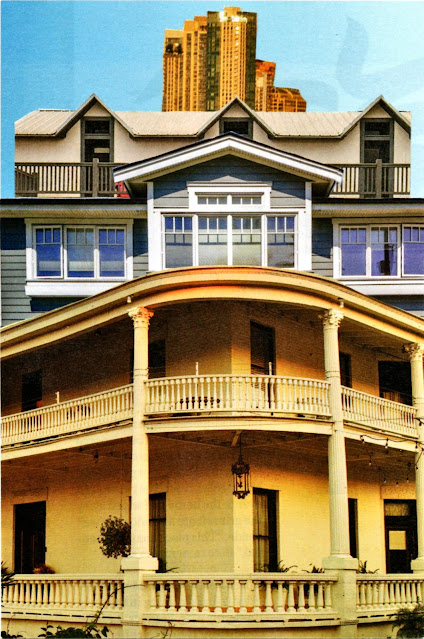In Houston what some call eclecticism others call ugliness. Such are the words most commonly thrown against the “Frankenstein Houses” that dot the city.
The term does not refer to any particular architectural style or the work of a single architect, but something closer to the opposite. The Frankenstein Houses are patchwork affairs, with wings and annexes added seemingly haphazardly with no regard to preexisting structures and styles. Bits of Greek and Colonial Revival provide the trunk for Victorian extensions and Craftsman floors dropped on top of older sections. Despite this variation, all of these houses have one commonality. The base structure of all of these houses is always the oldest piece of architecture both in style and in date of construction, and these base structures are almost always intact and separate from the additions, or, to put it another way, you do not need much of an imagination to see how these earlier structures might be excised wholly from the later additions.
The cause of this particular styling comes down to a legal loophole and the tastes and wants of the city’s wealthy elite. Like most cities, Houston has an eye for preserving its history. It has laws in place to protect its cultural and historic heritage and ensure that homes listed as “Historically Important” are free from the threat of demolition, though due to the exact wording of law, they are only free from “demolition” and “wanton alteration of their historic facades.”
This to-the-letter definition was codified when the Haight family purchased the historic Ashley Mansion. Finding it too cramped, they sought to build an extension to the east wing. The city tried to stop them, citing the historical preservation laws, and the Haights sued in retaliation. When the lawsuit was settled, it was decided that as long as the family did not demolish their home or do too much to alter its historic facade, then they were well within their rights as owners. They went ahead and built their wing, and a few years later added another, nothing too grand or serious, but the wealthy families of Houston took note and ran with the legality the Haights established. Premier architects were hired to design whole new floors and vast additions in modernist and contemporary styles, and whenever the city pressed against these renovations, the wealthy banded together to enforce their strict definition of the law.
The houses most commonly referred to as “Frankenstein Houses'' are those where the alterations are most notable, where styles clash and fight for the eye’s attention, but not all of the houses are such careless conglomerations. There are a fair number of historic homes whose new architecture was built to match the old, that only a trained eye could identify as being altered. Though these too are by definition “Frankenstein Houses,” you will not find them on any of the walking tours given of the most garish monstrosities.
Practicalities:
There are a number of walking tours that pass by and discuss the craze of the Frankenstein Houses alongside the other architectural trends of Houston. Most range from an hour to two in length and tickets can be purchased for less than $20 a person.
Previous Postcard Next Postcard
